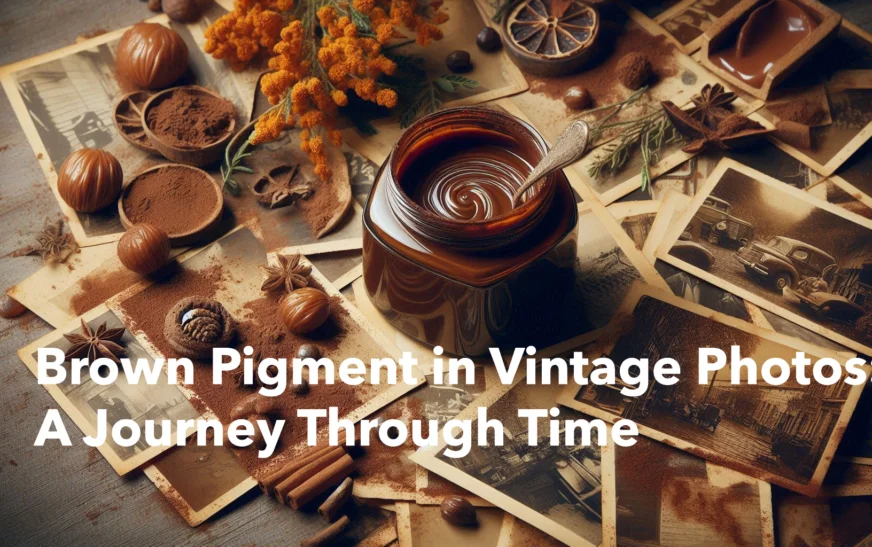Introduction to brown pigment in vintage photos
Vintage photos hold a unique charm that transports us back in time. One element that enhances their nostalgic appeal is the rich, warm tones created by brown pigment. This earthy hue not only adds depth but also evokes emotions tied to history and memory. Whether you’re a photographer looking to infuse life into your digital images or an artist seeking inspiration from physical mediums, understanding how to incorporate brown pigment can elevate your work significantly. Join us as we delve into the fascinating world of brown pigment in vintage photos and explore techniques, tips, and creative ideas for making those timeless images even more captivating!
Understanding the history and significance of brown pigment in vintage photos
Brown pigment has a rich history in photography. In the early days, photographers often used it to evoke warmth and nostalgia. This choice added depth to images, making them feel more intimate.
Historically, brown pigments were derived from natural sources like earth minerals. These organic materials provided unique hues that synthetic pigments couldn’t replicate.
As photography evolved, so did the techniques for applying these colors. Brown tones became synonymous with vintage photos, enhancing their sentimental value.
The significance of brown lies in its ability to transport viewers back in time. It creates an emotional resonance that many contemporary images lack. This connection is especially important as we seek authenticity in a world driven by digital perfection.
Using brown pigment is not merely about aesthetics; it’s about storytelling and preserving memories through color choices that echo the past.
Techniques for adding brown tones to digital photos
Adding brown tones to digital photos can transform your images into nostalgic masterpieces. Start by using photo editing software like Adobe Lightroom or Photoshop.
Begin with color grading tools. Adjust the temperature slider slightly towards yellow for warmth. This instantly infuses a subtle brown hue.
Next, explore split toning options. Apply shadows in a soft brown tone while keeping highlights brighter, creating a beautiful contrast that evokes vintage charm.
Experiment with filters designed for vintage effects. Many apps offer pre-set options that replicate classic film styles filled with rich browns and muted colors.
Don’t overlook texture overlays; adding grain can enhance the retro feel of your image. Search for textures online or create your own by photographing fabric or paper and blending them in layers.
Adjust brightness and contrast carefully to maintain the natural look while emphasizing those warm tones throughout your photo.
Tips for using physical brown pigment in vintage photos
When working with physical brown pigment in vintage photos, start by selecting high-quality materials. Choose archival safe pigments to preserve the integrity of your images.
Experiment with different application methods. A soft brush can create subtle washes, while a sponge might yield bolder textures. Test techniques on scrap paper first to avoid unwanted results.
Layering is key. Start light and gradually build up the intensity of the brown tones for depth and dimension. This approach allows you to maintain control over the final look.
Don’t forget about blending! Use a dry cloth or your fingers to soften edges and create seamless transitions between colors.
Protect your finished work with a fixative spray designed for photographs. This will help ensure that your enhancements remain vibrant over time without fading or smudging.
Creative ways to incorporate brown pigment in vintage photos editing process
Experiment with layering textures. Use brown pigment overlays to add depth. This technique can transform a flat image into something rich and dynamic.
Consider using blending modes in your editing software. Soft light or multiply options can create stunning effects when combined with brown hues. It’s all about finding the right balance that enhances your photo without overpowering it.
Don’t shy away from experimenting with brush tools as well. Create custom brushes that mimic natural pigments for more authenticity.
Try selective coloring too. Highlight specific areas of an image while allowing other sections to retain their original tones, creating a striking contrast against the warm browns.
Remember to adjust opacity levels strategically. This subtle approach allows you to maintain clarity while infusing warmth into your vintage photos, resulting in captivating imagery that tells a story through color.
The impact of using brown pigment in vintage photos on the overall aesthetic of vintage photos
Using brown pigment in vintage photos can dramatically alter the aesthetic appeal. The warmth of browns evokes a sense of nostalgia and history. It transports viewers to another time, creating an intimate connection with past moments.
Brown tones lend depth and richness to images. They soften harsh contrasts, providing a more cohesive look that feels timeless. This subtlety enhances details without overwhelming the viewer’s eye.
Moreover, incorporating brown pigments can unify various elements within a photo. Shadows become gentler while highlights gain character, resulting in an overall harmonious composition.
Additionally, these earthy hues resonate emotionally with many audiences. They evoke feelings of comfort and familiarity—qualities often sought after in vintage photography.
The strategic use of brown pigment invites exploration and storytelling through imagery. Each shade tells its own tale while paying homage to the artistry behind capturing life’s fleeting moments.
Conclusion:
Exploring the use of brown pigment in vintage photos opens up a world of creative possibilities. This rich color has historical significance, adding warmth and depth to images that might otherwise feel flat or lifeless. Understanding its roots enhances the appreciation for vintage photography.
When it comes to digital editing, various techniques allow you to seamlessly incorporate brown tones into your images. From adjusting color balance to using filters, these methods can transform modern shots into timeless pieces. For those who prefer hands-on approaches, physical pigments offer unique textures and effects that can elevate any photograph.
Creativity knows no bounds when integrating brown pigment during the editing process. Whether you’re creating a nostalgic atmosphere or conveying mood through subtle hues, experimenting with different applications can yield stunning results.
The impact of incorporating this hue cannot be overstated; it infuses photographs with an aesthetic reminiscent of bygone eras while maintaining relevance today. By embracing both traditional and modern techniques, enthusiasts can celebrate the beauty found in vintage photography through the lens of brown pigment.
Harnessing this element not only enriches individual images but also contributes to a broader appreciation for art and history intertwined within each frame captured over time.





